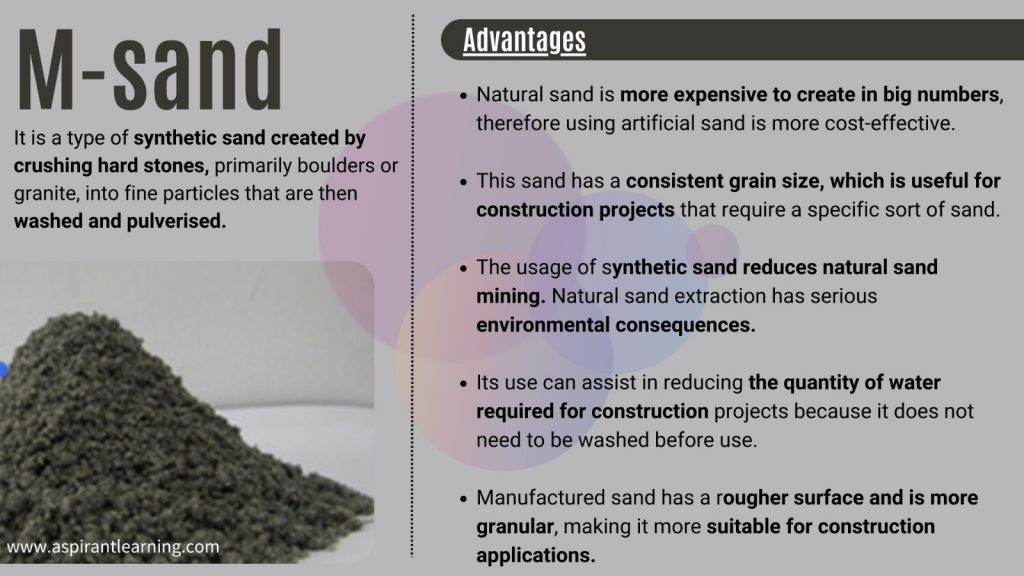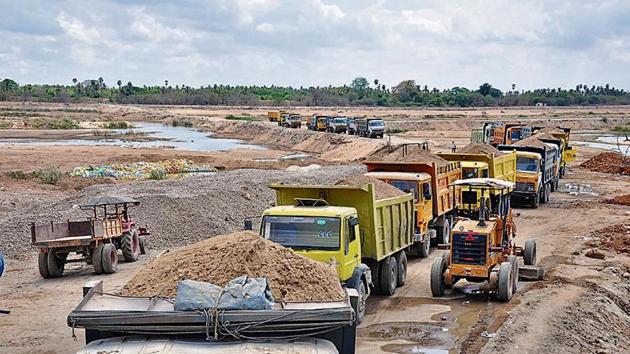News Highlight
Coal India Ltd to Launch M-Sand Projects in a Big Way: Focus on Cost-effective and High-Quality Sand Production.
Key Takeaway
- Sand is classified as a “minor mineral” under the Mines and Minerals (Development and Regulation) Act 1957.
- The Ministry of Mines’ ‘Sand Mining Framework’ (2018) envisions alternate sources of sand in the form of sand (M-Sand) generated from crushed rock fines (crusher dust) from coal mine overburden (OB).
- The topsoil and rocks are removed as waste during ‘opencast mining,’ and the shattered rock (overburden or OB) is placed in the dump to recover the coal.
M-Sand Projects
- Aim
- Finding alternatives to river sand became necessary due to high demand and regulated supply.
- A complete prohibition on sand mining during monsoon to protect the river environment.
- Overview
- The Ministry of Mines’ Sand Mining Framework (2018) envisions alternate supplies of sand from M-Sand from crushed rock fines and sand from coal mine overburden (OB).
- Coal India Ltd (CIL) intends to process overburden rocks for sand production in mines where OB material comprises approximately 60% sandstone by volume.
- In addition, it will be harnessed through crushing and processing of Overburden.
Manufactured Sand (M-sand)
- About
- Firstly, it is synthetic sand created by crushing hard stones, primarily boulders or granite, into fine particles that are washed and pulverised.
- It is frequently used in construction as a substitute for river sand, primarily in creating concrete and mortar mixtures.
Benefits of M-Sand
- Environmental benefits
- Artificial sand can help eliminate the demand for natural sand mining, which can have significant environmental consequences.
- Furthermore, coal mine overburden can help recycle items that would otherwise be considered garbage.
- Consistency
- Manufactured sand can have constant grain size and shape, which is useful for construction projects that need specific sand.
- Cost-effectiveness
- Natural sand cannot be generated in such vast amounts at such cheap costs.
- Hence using artificial sand may be more cost-effective.
- Reduced water consumption
- It can help reduce the water needed for construction projects because it does not need to be washed before use.
- Better workability
- Manufactured sand has a rougher surface and is more angular, making it more suitable for construction applications.
- Reduce Erosion
- Less sand mining from rivers will reduce channel bed and bank erosion and protect water habitat.

Status of Sand Mining in India
- About
- Firstly, sand is classified as a “minor mineral” under The Mines and Minerals (Development and Regulations) Act of 1957 (MMDR Act).
- The primary sources of sand are rivers and coastal areas, and demand for it has expanded dramatically in recent years due to the country’s construction and infrastructure development boom.
- The Ministry of Environment, Forests, and Climate Change (MoEFCC) have released “Sustainable Sand Mining Management Guidelines 2016“.
- It is to promote scientific sand mining and ecologically friendly management methods.
Issues Related to Sand Mining in India
- Environmental Degradation
- Sand mining can cause habitat and ecosystem degradation and erosion of river banks and coastal areas.
- Water Scarcity
- Sand mining can deplete the water table, reducing the water available for drinking and irrigation.
- For example, it has caused a drop in the water level of the Luni River in Rajasthan, endangering the drinking water supply of adjacent villages.
- Floods
- Excessive sand mining can cause riverbeds to become shallow, raising the danger of flooding.
- For example, in Bihar, sand mining has led to increased flooding in the Kosi River, causing damage to crops and property.
- Corruption
- Sand mining is a highly profitable activity, and there have been instances of corruption.
- Bribery in the allocation of mining leases and the enforcement of regulations.
Way Forward
- Strict Regulation and Enforcement
- The government can regulate sand mining through legislation and impose harsh penalties for illicit mining.
- This can also include establishing a regulatory organisation to oversee mining operations and ensure compliance with applicable laws and regulations.
- Innovative Solutions
- The government can look for creative solutions to sand mining problems.
Pic Courtesy: Hindustan Times
Content Source: PIB



